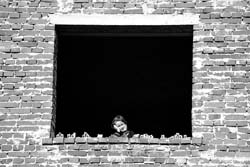Half the underage persons need social and legal protection

How comfortable is the life of children in today’s Ukraine? This was the subject of Friday’s presentation of the State Report on the Condition of Children in Ukraine. Among those who took part in the debate were representatives of UN agencies in Ukraine, Verkhovna Rada, the Cabinet of Ministers, ministries, international foundations, and NGOs. Many problems were raised that touch upon various points in the life of our population’s youngest segment. Many things proven unexpected. For example, UNICEF Ukrainian office chief Jeremy Hartley told The Day, “The quality of secondary and higher education has taken a downward trend in the years of independence. There are many factors responsible for this. One of the very important aspects in teaching children is preparing them to live a self-sufficient life in a democratic society. To do so, they must acquire the necessary knowledge and skills when they are still in school. It is important that children from the most vulnerable groups be granted equal opportunity with healthy and well-fed children for getting a quality education and participating in social life. What also arouses concern is the condition of preschool education in Ukraine, for a very low percentage of young children attend kindergarten. While about 90% of school-age children go to school, only every second or third child attends daycare facilities. Although not everybody can afford to pay for preschool education, there are resources provided for in the national budget, but they are generally misused.”
There are almost a total ten million children in Ukraine. As matters stand today, we do not take enough care of them, they often fall ill, and theirs ailments are becoming chronic. They are increasingly affected with respiratory tract infections and skin lesions, while senior children also suffer from injuries and poisoning, which accounts for more than 6% of all illnesses. In 2002, the number of HIV-infected children rose one and a half times, while tuberculosis was diagnosed for the first time in more than a thousand boys and girls. Budget appropriations for children’s health care have been increased by only 1% a year against total expenditures. Only every tenth child could go to a summer health center in 2002.
Experts note that chronic pathologies are caused by children’s gross overstrain in school, a disparity between the teaching methods and the individual particularities of pupils along with too frequent occurrence in textbooks of scientific terms and facts that can only be of use for narrow specialists but not for most of the schoolchildren in their further life. What also impairs health is hypodynamia and school furniture that does not fit the stature of pupils.
The number of comprehensive school teachers is declining. The teacher-pupil ratio is 1:13 in the city, 1:9 in the village, and 1:4 in private schools. There are more and more retirement-age teachers in schools. The outflow of teachers from schools reduces standards, which also contributes to likely conflicts with pupils. Inadequate funding also reduces the number of specialist classrooms. In the countryside, only half the schools have chemistry and biology rooms and fewer than a half have foreign language rooms. Only half of Ukraine’s schools are equipped with computers. Urban residents think that having to pay additionally for better teaching is the greatest problem that hampers getting a quality education, while rural residents put the blame on the territorial remoteness of good educational institutions. Almost all experts point out unequal access to a high- quality secondary and higher education because children from better-off families have an advantage over those coming from a poorer background. The former have rooms of their own, are taught by private tutors, and have all the required school textbooks. All this affects the way the child feels about himself in school.
Today, there are over 30,000 street children. When juvenile delinquency bodies examined the conditions in which problem children live, they concluded that more than half of them need social and legal protection. In the past year, the Internal Affairs Ministry has detected more than three thousand adults who have drawn children into criminal activities.
Ukrainian children have also been robbed of many cultural opportunities for spending their free time. Children’s literature now accounts for 5% of the total published, while in 1980 every third book was published for children. At the same time, 14% of the surveyed teenagers regularly imbibe alcohol, half of seventh graders have already tried to smoke, and every fourth tenth grader is a heavy smoker.






